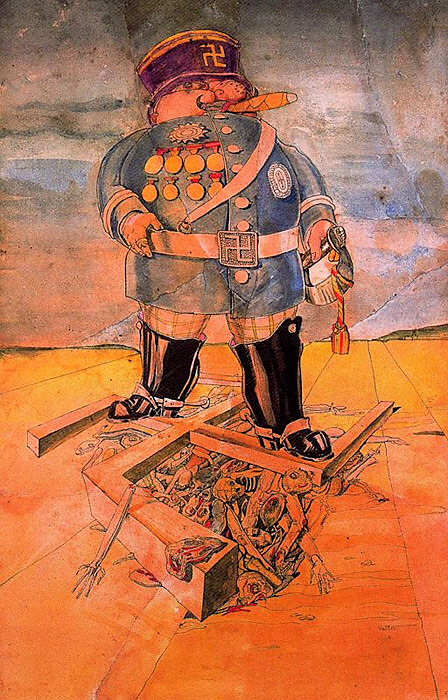
In the 1930's, when the rise of fascist parties and their violent manifestations had become a threatening reality, Jewish artists joined movements like Surrealism, escapism and Socialist Realism, representing two opposing ways of dealing with the crisis. On one hand, escapism in a dream-like universe typical of Brauner’s and Perahim’s Surrealist works attempted to deny the grim reality, but even so conveyed a sense of haunting anxiety. A more successful form of escape, was that of a mystical, worry-free, Chagall-like perspective as presented by Margareta Sterian.
On the other hand, the militant art of 1930s Socialist Realism, directly exposed the fascist threat. Lesser known artists such as Leon Alex, Erno Tibor, Iosif Klein and Aurel Mărculescu employed this technique, to present the poverty of the lower classes and to deal with social issues like anti- fascism. Besides they put forward the aesthetic of the ugly, resorting to a sharp schematic depiction of the subject. In the absence of individual features, figures and their attitudes become forms of expression more important in the interpretation of subjects. Leon Alex managed to delineate the Nazis’ dehumanizing tactics via grotesque figures anticipating the Holocaust by almost a decade.
The anti-Semitic policy instated in the late 1930's destroyed the flourishing Romanian art world. Those were very difficult years for Romanian Jews, and for artists, who like other Jews, suffered from anti-Semitic attacks. In a cartoon published in the fascist Romanian newspaper Porunca vremii (Order of the Hour), Maxy is described as the Jew Maxi, having a large nose, painting with "kosher ink" and "poisoning" the art with the venomous snake which he uses as a brush.
From 1940 to 1945, Jewish artists were banned from exhibiting in public galleries. During the Holocaust, some of the artists died in concentration camps or immediately after liberation, while their artistic careers were on the rise. Among them, Alex Leon, Erno Tibor and Iosif Klein. Others survived, but the experience of the Holocaust changed them: some of them left Romania either before the Holocaust or after, among them Iosef Iser, Victor Brauner, Marcel Iancu, Arthur Segal and Jules Perahim. Others, among them, M. H. Maxy, Lola Shmierer Roth stayed in Romania, but abandoned avant-garde techniques for Socialist Realism, while others, like Lazar Zin, and Mina Byck Wepper, gave up entirely on their artistic career. Arnold Daghani and Egon Marc Lovinth who survived the concentration camps, dedicated their art to documenting the struggle for existence.
Amelia Pavel, Pictori Evrei din Romania, Jewish Painters in Romania 1848-1948, Bucharest, 1996
Monica Enache, Valentina Iancu, Destine la Rascruce- Artisti evrei un perioada Holocaustului,
Catalogue of the exhibition held at the Bucharest Muzeul National de Arta, Oct.11, 2010-Feb.13, 2011